St John's Anglican Church
Toorak
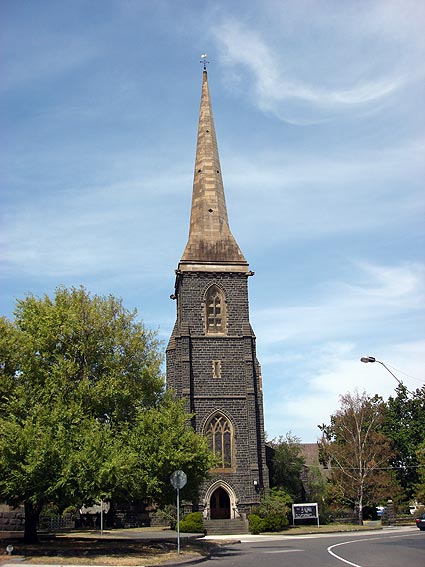
From the Sydney Organ Journal Winter 1996 - by John Maidment
History. St John's Church, Toorak is the only Anglican church design by the noted Catholic architect William Wilkinson Wardell (1823-1899). It was built in various stages from 1860 until the 1930s. Prominently sited at the peak of a lofty hill, its elegant broach spire may be seen from as far as the city. Designed in the decorated Gothic style and built of bluestone and sandstone, the interior incorporates many imposing memorials, particularly the stained glass windows by local and overseas makers and a wealth of wood carving, together with opus sectile mosaic wall panels.
St John's has had a total of four pipe organs in its 135-year history, The first was an anonymous instrument for which details are unknown, and was used only for a few years. The second organ was the single-manual instrument of 11 stops now in St Jude's Anglican Church, Carlton built in 1868 by George Fincham. The third instrument was built in 1870 by the illustrious firm of Merklin Schütze of Brussels under the superintendence of Pierre Schyven and destined for "Melbourne: Cathédralé", according to the firms' records. It had three manuals and 28 stops, although the stops of the Positif were borrowed by mechanical transmission from the Grand Orgue (a Merklin patent), and included a chorus of three reed stops on the latter manual: Basson 16p, Trompette Harmonique 8p and Clairon 4p. This instrument was removed from St John's in 1914, rebuilt by Meadway & Slatterie, and installed at the Methodist Church, Elsternwick. It is still located in this building, although the later pneumatic action (replacing the original barker lever?) is now defunct and the instrument virtually unplayable. It cries out for a sympathetic reconstruction. [now in storage at the Australian Catholic University, St Patrick's Campus, Fitzroy, Melbourne]

The Hill & Son organ for St John's Church was the last of 39 organs exported to Australia by the firm before its amalgamation with Norman & Beard. With a job number of 2432, it was built in 1913 in the firm's York Road works under the superintendence of Dr Arthur Hill. The consultant was Dr William George Price., Melbourne City Organist, who was also Organist at St John's. It is interesting that the choice of Hill as the builder may have been due to Price's association with the firm when it rebuilt the organ at Ulster Hall, Belfast, where he had been Organist before emigrating to Australia. Hill was responsible for the design of the splendid oak case which has allusions to the organ at Zaragoza Cathedral, Spain drawn by Hill for his books on European organ cases. The organ was given by the Connibere family in memory of their father George Connibere, a Devon-born draper and Mayor of St Kilda who died in 1911.
A purpose-built chamber was built on to the north side of the chancel for the reception of the Hill instrument. It is exceptionally spacious, the floor being lower than the main church floor while there is a sloping ceiling to deflect the- sound into the building. The organ is also spaciously laid out with large slider soundboards for the great and swell divided by central passage boards and ample room for maintenance access. The great and swell stand behind the chancel facade while the choir speaks west, the soundboard being placed at right-angles to the other manual divisions. The pedal Bourdon is mounted high behind the swell box while the wooden Open Diapason and Trombone are sited at the side and rear of the chamber respectively. The organ was conceived on the grand scale with an immensely heavy building frame, huge wind reservoirs and massive swell boxes.
The 1960s rebuild. The Hill organ remained largely unscathed up to the end of the 1950s with only minor maintenance. By then it was said to have been in a very rundown state, so in accordance with contemporary taste it was not restored, but extensively rebuilt. This work was carried out by Hill, Norman & Beard (Australia) Pty Ltd, of Clifton Hill, Melbourne between May 1960 and August 1961. The consultants for the work were W.A.F. Brodie, John Mallinson and Norman Stringer. The original tubular-pneumatic action was removed and a new electro-pneumatic action installed. A new detached drawknob console was placed amongst the choir stalls on the south side of the chancel. Far-reaching tonal alterations were carried out including the transposition, removal and revoicing of original pipework, the introduction of considerable tonal extension, and the addition of new ranks of neo-baroque tonality. The work included a new unenclosed positiv division in place of Hill's enclosed choir organ. The removal of the original console led to the defacing of the oak case by the placement of cladding over the original panelling.
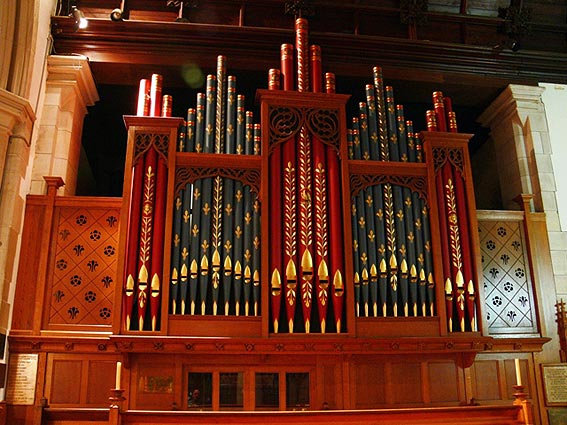
| Great Lieblich Bourdon Open Diapason 1 Open Diapason 11 Hohl Flute Dulciana Octave Principal Nason Flute Quint Superoctave Mixture Scharf Trumpet Swell Contra Salicional Open Diapason Rohr Flote Viole de Gambe Vox Angelica TC Principal Saube Flute Fifteenth Mixture Contra Oboe TC Horn Clarion Positiv Gedeckt Quintaden Gemshorn Nazard Octave Tierce Superoctave Cymbel Regal Hautboy Krummhorn Trumpet Pedal Open Wood Open Diapason Bourdon Lieblich Bourdon Grossquint Octave Principal Flute Quint Superoctave Octave Flute Rauschquint Trombone Krumhorn |
16 8 8 8 8 4 4 4 2-2/3 2 III-IV II 8 16 8 8 8 8 4 4 2 III-IV 16 8 4 8 8 4 2-2/3 2 1-3/5 1 II 8 8 8 8 16 16 16 16 10-2/3 8 8 8 5-1/3 4 4 II 16 4 |
A E A A B A C B D E F A F D E F F E F E/F C |
(ex Swell: unit chest) (ex Choir: in Double slide) (part new) (new: in Harmonic Flute slide) (ex Choir: in Bourdon slide) (ex Choir: in Vox slide) (part new) (unenclosed: old Choir chest) (new) (new) (new) (old Piccolo revoiced) (new) (new) (new) (ex Swell Vox Humana) (Orchestral Oboe: enclosed) (Clarinet: enclosed) (great Double Open with new bass) |
15 couplers
adjustable thumb & toe pistons
As a result of this work, the appearance and sound of the instrument were almost completely changed and the instrument became a travesty of Hill & Son's original intentions.

The restoration. By the late 1980s, the instrument was in poor tonal and mechanical shape. It was unanimously decided to restore the instrument as closely as possible to its 1913 specification, although retaining electro-pneumatic action. After reports and submissions were received from a number of organbuilding firms in Australia and overseas, the contract for the work was awarded to Peter D.G. Jewkes Pty Ltd, of Sydney, N.S.W. The work began in October 1994 with the dismantling of the instrument, the majority of which was removed to the builder's Sydney workshops for restoration, although much of the pipework remained in storage at the church.
The restoration was highly complex and involved much research and the careful reconstruction of missing parts. Contemporary Hill instruments in Australia (Pitt Street Uniting Church, Sydney) and in Britain (All Hallows', Gospel Oak, North London) were closely inspected to obtain accurate measurements and details. Additionally, through the British Organ Archive at Birmingham, administered by the British Institute of Organ Studies, detailed original drawings of the Toorak instrument were obtained, these enabling the reconstruction of the original internal layout, choir box and console stop layout.
The work was funded through a National Trust appeal with a target of $275,000. At the time of writing., less than $40,000 remained to be raised to achieve the appeal target.
The areas covered by the restoration are described below:
Actions. The original Hill pneumatic note actions for the unit chests were releathered and restored together with the soundboard underactions dating from 1961 . The massive pneumatic stop machines were releathered. A new solid-state switching and combination action was supplied by Solid State Logic Ltd and the whole organ rewired.
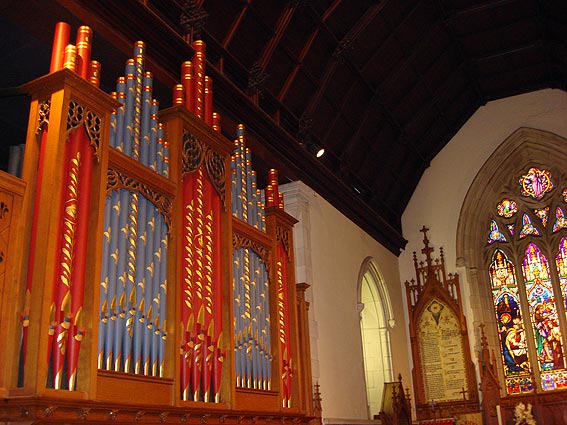
Case and facade pipes. In 1961 the case was disfigured by cladding the lower parts with oak sheeting. The lateral pierced panels had been removed and replaced with solid panelling and the impost brackets removed and destroyed. Fortunately all of the lower panelling survived, either behind the oak facing, or in storage, together with the pierced panels.
Much of the original casework had been damaged through these alterations and had begun to sag alarmingly through poor alignment and support.
All of the original casework was expertly repaired, holes and damage being rectified. Some new sections were made, including capitals for the lateral posts, some horizontal members and the destroyed impost brackets, the reeded profile of which was deduced from faded sections on the case uprights. The whole was rubbed down and repolished,
Assembly of the case proved to be a time-consuming procedure. Improved methods of support had to be arranged for the massive impost beam and additional bracing was fitted. It was necessary to jack up the badly warped impost beam and tie it back to the case uprights so that the whole fitted together precisely.
Facade pipe decoration. Before the restoration, the facade pipes were covered in ugly silver frost. The original finish was in aluminium, but it was desired to create a new and colourful design. The decoration was carried out by Marc Nobel and Christine Holmes. The design was evolved by Marc to give the instrument a vibrant and three-dimensional appearance in spite of a case design which has no projecting towers. The colours, a rich crimson and purple-blue, match the windows in the church, while the gilt decoration echoes that of Alfred Fuller's instruments in late-19th century Melbourne. The work was carried out at Clifton Hill and the pipes finally assembled into place in early November. The final result of pipes and case is breathtaking and has received much favourable comment.
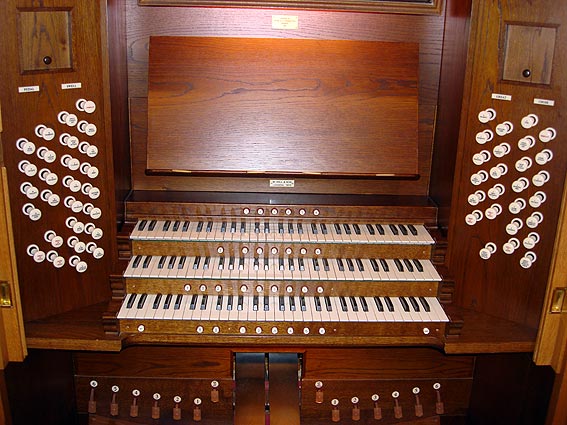
Console. A new attached drawknob console was constructed. This was closely modelled upon contemporary Hill practice in the absence of any photos of the original Toorak console. Photographs of other contemporary instruments (from such sources as the Hill firm's The Art of Organ Building) were closely examined and the final design evolved. The use of computer-aided design (CAD) technology greatly assisted in refining the design, particularly in relation to the placement of the general pistons and music desk. Profiles of the scrolled Hill keycheeks at Pitt Street Uniting Church, Sydney (from John Stiller's documentation for OHTA) were used to replicate this essential feature. New drawstops and ferrules were turned up in ivory resin, a new synthetic substance having the appearance (grain) and tactile feel of ivory: the profile of the knobs was replicated from a surviving specimen of 1913. The same material was used for the new keyboards and thumb pistons, while the combination pedals are elegant brass levers, Most of the console components were manufactured by P & S Organ Supplies, of Brandon Suffolk, who did a splendid job. The woodwork is of stained and polished American oak, very close, we believe, to the original finish.
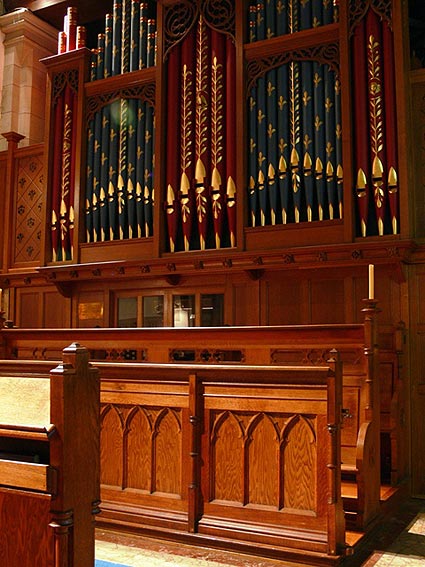
Frame. The original building frame had been modified to support the original Choir soundboard at a lower level forming an unenclosed Positiv division. Fortunately, the two vertical posts survived and when reconstructing the position of the enclosed Choir it was only necessary to make new horizontal supporting beams.
The frame had been badly bashed in the past: there were many visible hammer-blow marks. These were filled and the whole repainted in the Hill green-black paint colour, care being taken not to overpaint any of the original stencilled markings. The frame was also carefully levelled up and bolted together.
Pipework. The present work has seen the reversal of all the 1961 tonal changes. This was achieved through the reconstitution of the original design, involving the replacement of pipework back to its original division and pitch. As several ranks had been transposed, new top octaves had to be made, while replacement rackboards had to be fitted in several instances.
Fortunately the original upperboards had been retained, fitted with veneers and redrilled, so it was a straightforward (although time consuming) task to restore them to their original configuration.
New pipework had to be made for the missing choir Lieblich Gedeckt (from tenor C upwards) and the Great Harmonic Flute. The scales were obtained from the near- contemporary Hill organ at Pitt Street Uniting Church, Sydney (using John Stiller's documentation) and the pipework made by F.J. Rogers, of Leeds. The Gedeckt was fitted with turned wooden stoppers after the Hill style.
The basses of the chorus reeds required extensive resonator repairs and strengthening, owing to collapse, and these and other pipe repairs were expertly carried out by Australian Pipe Organs,
The original two three-rank Mixtures had been scrambled in 1961 to remove the seventeenth partials and to introduce greater brightness. The original pipes were clearly stamped with stop, rank and pitch designations, so it was possible to reconfigure the pipework. Only eight pipes were found to be missing out of a total of 366.
In 1961, much of the pipework had been reregulated. This greatly affected the overall balance and cohesion of the instrument, Many ranks sounded characterless and failed to blend.
Restoration of the original balances, together with repatriation of the pipework, has given miraculous results.
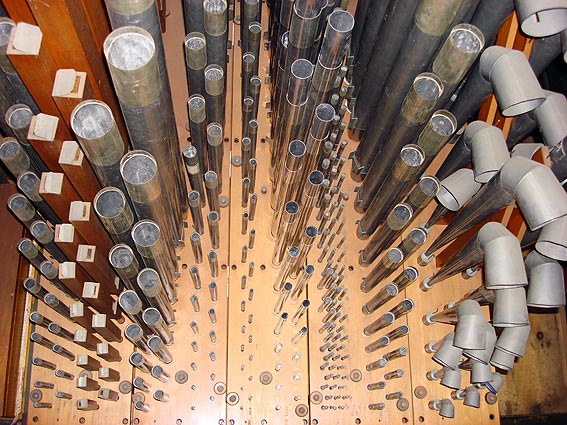
Soundboards. These were fully dismantled, flooded with hot animal glue, planed flat, and all working surfaces coated with graphite. The upperboards were shellac-polished and the external surfaces painted in Hill paint colour. This work was especially time-consuming owing to the poor physical state of the soundboards, which had split in several places and been subject to crude repairs in the past. Where ranks had been swapped or changed, the upperboards had been veneered: the veneers were cut away and the original design reconstructed.
Swell boxes and actions. With the reinstatement of the original enclosed Choir Organ, a new swell box for this division had to be made. The rear of this box abuts on to the C side of the swell box, so that it was necessary to construct a new side wall, with access door, and two shutter fronts, one facing west and the other south. The original box only had a narrow shutter front facing south., so it was decided, for improved tonal egress, to have a second front and to incorporate the tuning passage board within the box rather than outside it.
In 1961 the mechanical swell pedal actions were replaced with whiffle tree actions. The mechanical actions have now been reconstructed. This involved the construction of enormous iron lateral rods, resting on bearings, and T-section wooden vertical trace rods to the shutters. The design of these actions was especially complex given the provision of opposing sets of shutters for the Swell and the dual shutter fronts on the Choir.
Wind system. The original Hill wind system survived the 1961 rebuild relatively unscathed, apart from the removal of the original bellows feeders and large amounts of subsidiary trunking (replaced in 'Kopex'). The wind system is on a grand scale and of the most substantial construction, incorporating five double-rise reservoirs. The original control valves could only be seen upon full dismantling, these incorporating beautifully polished pulleys and roller blinds,
Reassembly of the trunking again proved very time-consuming. New subsidiary zinc trunks were made by Australian Pipe Organs for the pneumatic stop machines and tremulants, together with pipe metal conveyances for the Choir basses. A new wooden trunk was made for the repositioned Choir soundboard.

Site preparation. Concurrently with the organ restoration, the organ chamber was refurbished. The walls and ceiling were repainted, the latter in a matt black paint so that it remains invisible behind the organ case. The floor was sanded and lacquered while the electrical wiring was upgraded. The lintel beam over the organ chamber, previously painted white, was veneered in dark timber to match the chancel ceiling and to remain visually unobtrusive behind the organ case. The chancel seating was also reorganised and taken back to its original configuration following alterations to accommodate the detached console. The flooring under the seating was also sanded and lacquered. With the enhancement of all surfaces within the chamber, a far greater degree of tonal reflection has been achieved than existed previously.
Summation. In spite of a non-resonant acoustic, it is surprising how the instrument absolutely transcends this limitation, owing to inspired voicing, substantial construction and ample scales. The integrity of the overall sound enables a wide selection of music to be performed, and it must be said that Bach sounds a great deal more convincing now than it did after the neo-classicising attempts of 1961.
The sound is instantly recognisable as that of the Hill stable, especially the Great chorus from 16ft to Mixture, which harkens back to the 1880s. It is only when the heavy-pressure ranks are added that the sound becomes distinctively Edwardian. The chorus reeds are now bright-toned and resonant Posaunes rather than bland Trombas, The pedal Trombone, which has parallel leathered shallots, with brass and lead/felt-weighted tongues, is an exceptional reed, with great brilliance and drive (this had been emasculated in 1961 through the draping of carpet over the resonators!). The softer sounds are also exquisite, in particular the Swell and Choir flutes and strings, while the orchestral reeds are immensely successful and belie their 60s transformation to baroque reeds!
There is now a wonderful integration of sound, an infinite range of vibrant colour, weight, brilliance and drive. This is certainly the most remarkable resuscitation we have yet heard and the builders are to be congratulated on an outstanding result vastly exceeding all initial expectations.

The work team. The work was an outstanding team effort by the following people:
RODNEY FORD: Site supervision throughout. Swell & Great soundboard restoration. Case restoration, Console. Wiring throughout. Chamber preparation and 'levelling'.
JOHN PARKER: Off-note and Pedal chest restoration. Racking in of Choir pipework. Site erection assistance. Cleaning of solo reeds. Restoration of Swell Bourdon,
DAVID MORRISON: Concussion bellows releathering, tremulants, wind trunking, etc. including new wooden trunks. Site dismantling and erection assistance. Choir soundboard restoration. Shutter actions., etc.
MARTIN ENGELKE: Case restoration including mouldings & capitals. Choir soundboard restoration. Console.
BRIAN ALCOTT (3rd year apprentice): Choir building frame modifications, building frame restoration and painting, Rackboard filling, restoration, re-racking of Swell and Great ranks. Wooden and zinc trunk restoration. Site erection assistance and action regulation.
IAN KERRIS (1st year apprentice): Roller-blind restoration. General assistance including site erection.
PHILIP MIERISCH: Choir box construction. Site erection assistance, 'levelling', etc.
DAVID HUDD: Bellows releathering. Site dismantling & erection assistance. Ongoing maintenance representative.
KATE BUTTERY: General assistance on site with dismantling, erection, painting, tonal finishing, etc.
RAY PETTERD: On-site voicing assistance and tonal finishing.
PETER CLARKE (of Pimlico Polishing): Case and console polishing.
PETER JEWKES: Administration., planning, design, voicing, site dismantling and erection assistance, action regulation, tonal finishing and final tuning.
Re-opening recital. The re-opening recital was given by John Scott, Director of Music at St Paul's Cathedral, London on Friday 2 February 1996. Before a capacity audience of 570, he performed works by Hollins, Bach, Mozart, Mendelssohn, Smart, S.S. Wesley, Vaughan Williams, Whitlock and Dupré concluding with encores by Purcell and Handel. The recital was received with great rapture by the audience - probably the largest to attend such an event in Melbourne for many years.
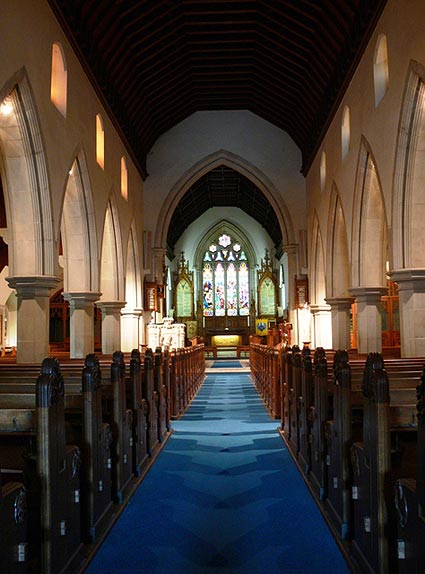
SPECIFICATION OF THE ORGAN WILLIAM HILL & SON, LONDON 1913
RESTORED BY PETER D.G. JEWKES PTY LTD, SYDNEY - 1995
GREAT ORGAN - CC to C - 61 notes - Manual II
9 stops, 2 couplers, 11 ranks, 671 pipes
Wind pressures - fluework 3 1/4", heavy wind 6"
| Double Open Diapason Open Diapason I Open Diapason II Hohl Flute Principal Harmonic Flute Fifteenth Mixture Trumpet Swell to Great Choir to Great |
16 8 8 8 4 4 2 III 8 |
~B * *ø |
SWELL ORGAN - CC to C - 61 notes, Manuel III
12 stops, 3 couplers, 14 ranks, 844 pipes
Wind pressures - 3 1/4". heavy wind 6"
| Lieblich Bourdon Open Diapason Rohr Flute Echo Gamba Voix Celestes (A#) Principal Fifteenth Mixture Oboe Vox Humana Tremulant Horn Clarion Sub Octave Unison Off Octave |
16 8 8 8 8 4 2 III 8 8 8 4 |
* ø * ø |
CHOIR ORGAN (enclosed) - CC to C - 61 notes - Manual 1
8 stops, 5 couplers, 8 ranks, 488 pipes
Wind pressures - 3 1/4", Tuba 10"
| Dulciana Salicional Lieblich Gedeckt from c' Suabe Flute Piccolo Orchestral Oboe Clarinet Tremulant Tuba Sub Octave Unison Off Octave Swell to Choir Great Heavy Wind on Choir |
8 8 8 4 2 8 8 8 |
^ + ø |
PEDAL ORGAN - CCC to F - 30 notes
8 stops, 3 couplers, 4 ranks, 156 pipes
Wind pressures - fluework 3 1/2", Trombone 6"
| Acoustic Bass Open Diapason Violone Bourdon Octave Violoncello Bass Flute Trombone Great to Pedal Swell to Pedal Choir to Pedal |
16 16 16 16 8 8 8 16 |
A A B C A + C |
COMBINATION ACTION
6 General Pistons
6 Thumb Pistons each to Great Swell & Choir
6 General Combination Pedals
6 Combination Pedals to Pedal
Great and Pedal pistons coupled
General Cancel thumb piston
Set thumb piston
Adjustable solid-state capture system with 8 memories and separate control for general pistons
Capture and multiplex transmission systems by Solid State Logic Ltd, England.
REVERSIBLES
Great to Pedal (thumb piston and toe pedal)
Swell to Pedal (thumb piston)
Choir to Pedal (thumb piston)
Swell to Great (thumb piston and toe pedal)
Choir to Great (thumb piston)
Swell to Choir (thumb piston)
BALANCED MECHANICAL PEDALS
Swell expression
Choir expression
ACTION
Electro -pneumatic
MIXTURE COMPOSITIONS
Great III: C-f#1 17.19.22; go-a#' 15.19.22; b I-C4 8.12.15
Swell III: C-bl 17.19.22; c'42 12.15.17; f#2-C4 8.1115
PITCH
A = 440 at 200C
* heavy wind
^ 1995 Hill replica pipework (Ch Lieblich 8 from c 0)
+ 1995 additions (prepared for)
~ CC-GG# from 1961 rebuild.
ø harmonic trebles
John Maidment, who is chairman of the Organ Historical Trust of Australia, was a consultant for the restoration of the St John's organ. He has advised on similar projects at St Paul's Cathedral, Melbourne and St Mary's, Star-of-the-Sea Church, West Melbourne.
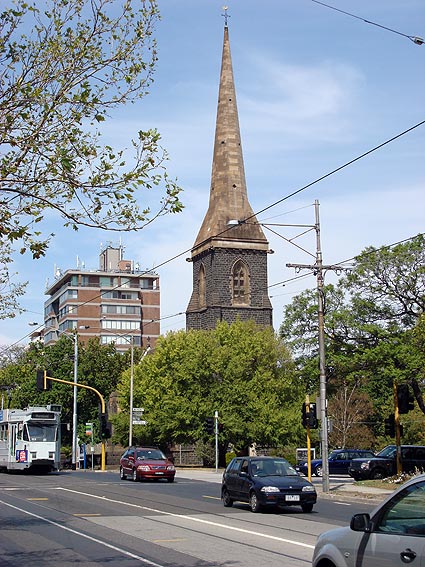 |
 |
|
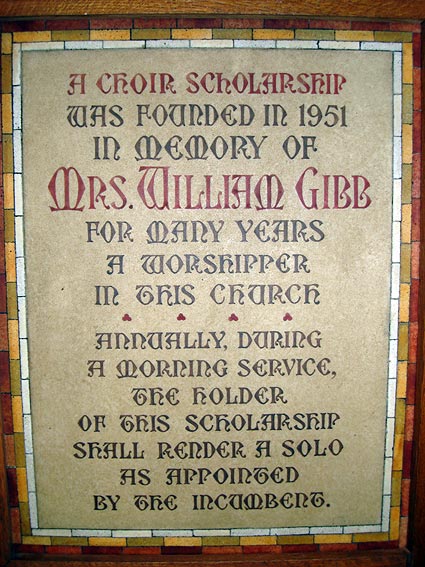 |
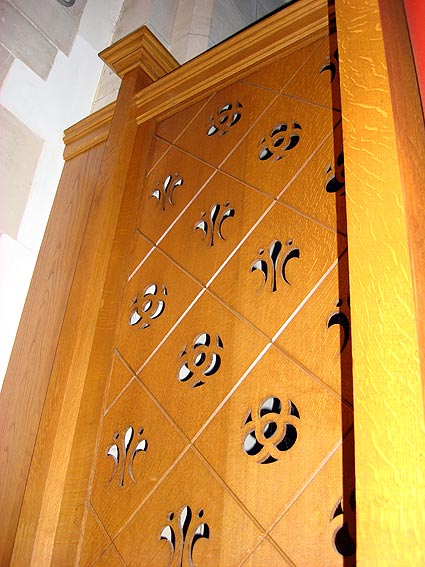 |
|
 |
||
Photos supplied by JRM and Peter Jewkes (2007)
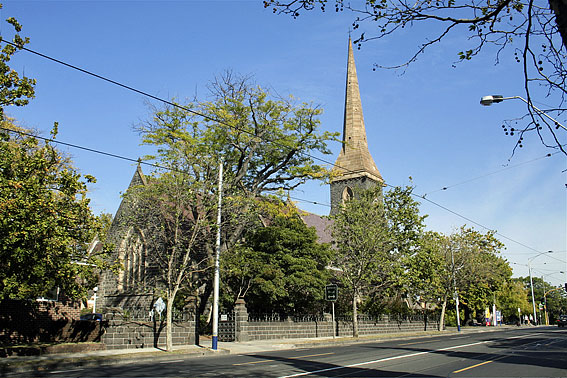
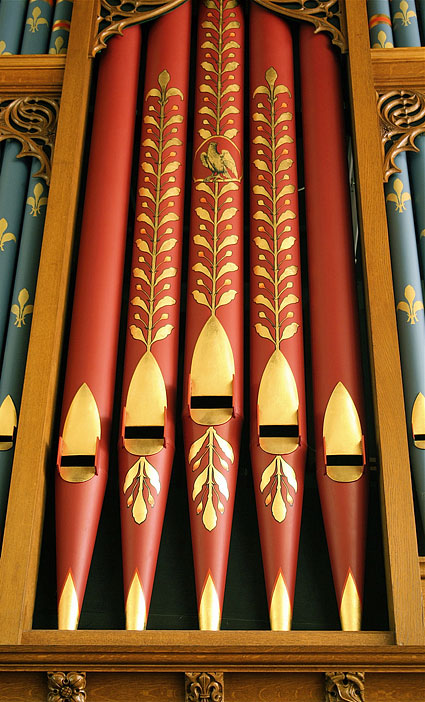

3 photos above: Trevor Bunning (April 2009)